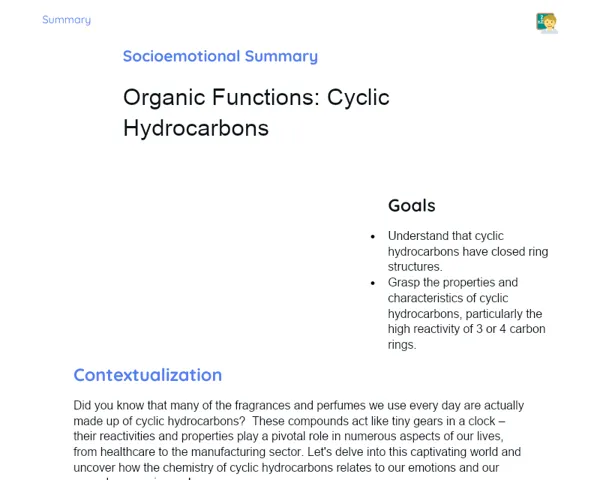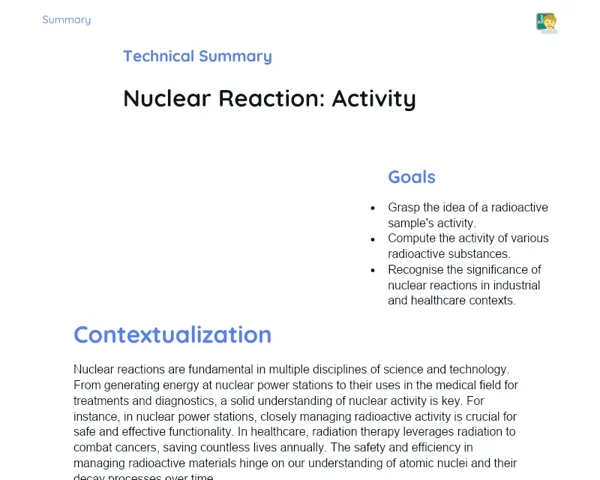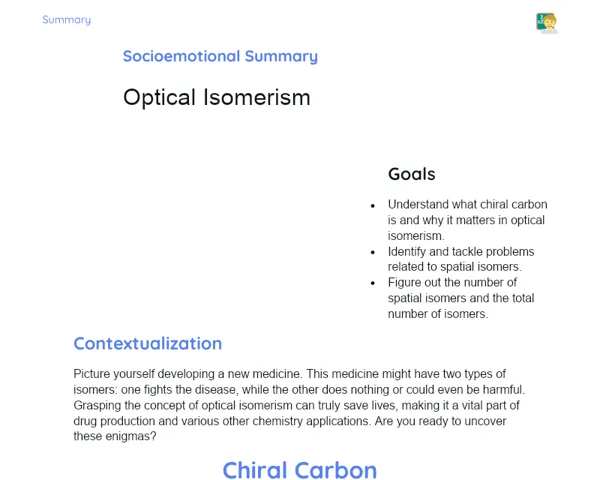Summary Tradisional | Organic Functions: Alcohol
Contextualization
Alcohols are a group of organic compounds that we encounter regularly in our daily lives, playing significant roles across various industries such as healthcare, beauty products, and the liquor trade. Chemically, alcohols are defined by the presence of a hydroxyl group (–OH) attached to a carbon atom. Depending on how many other carbon atoms are connected to this carbon, alcohols can be classified as primary, secondary, or tertiary. Understanding this characteristic is key, as it impacts both the physical and chemical behaviour of alcohols, as well as their diverse industrial uses.
In our everyday lives, you might find familiar examples of alcohols like ethanol, which is present in alcoholic drinks and serves as a fuel, or methanol, used primarily as a solvent in industrial settings. These substances are renowned for their distinct properties, including their ability to form hydrogen bonds, which directly affect their boiling points and solubility in water. Grasping these properties is vital for applying alcohols in various contexts, from making personal care items to creating new organic compounds.
To Remember!
Definition and Structure of Alcohols
Alcohols are organic compounds marked by the presence of a hydroxyl functional group (–OH) bound to a carbon atom. This carbon atom can be classified in three ways: primary, if it's linked to just one other carbon; secondary, if it bonds with two other carbons; and tertiary, if it connects with three. This classification is essential, as it affects the properties and reactions of alcohols.
The structure of alcohols is integral to their various physical and chemical attributes. For instance, the hydroxyl group's presence makes alcohols polar, enabling the formation of hydrogen bonds between molecules. These bonds are responsible for key characteristics of alcohols, including their elevated boiling points and their capacity to dissolve in water.
Moreover, the structure of alcohols is critical for their numerous industrial applications. For example, ethanol, a two-carbon alcohol, is commonly used in alcoholic beverages and as a fuel, while methanol, with one carbon, primarily serves as an industrial solvent.
-
Alcohols possess a hydroxyl functional group (–OH) attached to a carbon atom.
-
The carbon to which the hydroxyl group is attached could be primary, secondary, or tertiary.
-
The architecture of alcohols permits hydrogen bond formation, impacting their physical and chemical properties.
Nomenclature of Alcohols
The names of alcohols are derived following the guidelines laid out by the International Union of Pure and Applied Chemistry (IUPAC). To properly name an alcohol, one must identify the main chain, which is the longest series of carbon atoms that includes the hydroxyl group. The carbon atoms in the main chain are numbered to ensure that the hydroxyl group gets the lowest possible number.
The name of the alcohol is created from the original hydrocarbon name, with the suffix '-ol' added. For example, the alcohol with two carbon atoms is termed ethanol, while the alcohol with three carbons, where the hydroxyl group is on the first carbon, is referred to as propan-1-ol. If there are substituents on the main chain, they are named in alphabetical order and identified by their respective numbers.
Furthermore, alcohols can also be categorised as primary, secondary, or tertiary based on the position of the hydroxyl group within the carbon chain. This classification impacts the understanding of the chemical reactions that alcohols can participate in, such as oxidation.
-
The nomenclature of alcohols adheres to IUPAC rules.
-
Identify the main chain and count the carbon atoms so that the hydroxyl group gets the lowest number.
-
Add the suffix '-ol' to the name of the corresponding hydrocarbon.
Physical Properties of Alcohols
Alcohols have distinctive physical properties largely due to the presence of the hydroxyl group. One significant property is their comparatively high boiling point when matched with hydrocarbons of a similar molecular weight. This results from the ability of alcohol molecules to form hydrogen bonds, which are strong intermolecular forces that necessitate more energy to break.
Another key physical property of alcohols is their solubility in water. Thanks to the hydroxyl group, alcohol molecules are polar, which allows them to create hydrogen bonds with water molecules. Consequently, short-chain alcohols like methanol and ethanol are highly soluble in water. However, as the carbon chain lengthens, the water solubility of the alcohols diminishes due to the increasing non-polar character of the molecule.
Additionally, alcohols showcase viscosity, which is the measure of a fluid's resistance to flow. The viscosity tends to rise with the length of the carbon chain and the number of hydroxyl groups present in the molecule. These physical traits are pivotal for informing the practical uses of alcohols in various industry sectors.
-
Alcohols boast high boiling points due to their hydrogen bond formations.
-
The water solubility of alcohols diminishes as the carbon chain increases.
-
The viscosity of alcohols intensifies with the carbon chain length and the number of hydroxyl groups.
Chemical Reactions of Alcohols
Alcohols participate in a variety of essential chemical reactions, including oxidation, esterification, and dehydration. Oxidation of alcohols is a common response, differing based on the alcohol type. Primary alcohols can be oxidized to form aldehydes and subsequently carboxylic acids. Secondary alcohols convert into ketones, while tertiary alcohols are generally resistant to oxidation.
Esterification occurs when an alcohol reacts with a carboxylic acid, resulting in the formation of an ester and water. This process is facilitated by acids and is vital in producing esters, often used for fragrances and flavourings. For instance, the reaction between ethanol and acetic acid generates ethyl acetate, an ester known for its pleasant scent.
Dehydration of alcohols involves eliminating a water molecule to create an alkene. This reaction typically requires an acid catalyst and high temperatures. Dehydration is a significant method for synthesizing alkenes from alcohols and finds extensive use in the chemical industry.
-
Primary alcohols can transform into aldehydes and carboxylic acids via oxidation.
-
Esterification leads to the creation of an ester and water from an alcohol and a carboxylic acid.
-
Dehydration of alcohols yields alkenes and necessitates an acid catalyst.
Key Terms
-
Alcohols: Organic compounds with a hydroxyl functional group (–OH) bound to a carbon atom.
-
Hydroxyl: The functional group (–OH) found in alcohols.
-
IUPAC: The International Union of Pure and Applied Chemistry, which oversees the chemical nomenclature.
-
Oxidation: A chemical reaction marked by the loss of electrons, leading to the formation of new compounds.
-
Esterification: A reaction between an alcohol and a carboxylic acid producing an ester and water.
-
Dehydration: A chemical reaction where a water molecule is removed, yielding an alkene.
-
Ethanol: A type of alcohol containing two carbon atoms, commonly used in alcoholic drinks and as fuel.
-
Methanol: A type of alcohol with a single carbon atom, used primarily as an industrial solvent.
Important Conclusions
In this lesson, we thoroughly examined alcohols, a category of organic compounds defined by the hydroxyl group (–OH) connected to a carbon atom. We discussed the structure of alcohols—classifying them as primary, secondary, or tertiary—and how this impacts their physical and chemical properties. We also addressed the nomenclature of alcohols in accordance with IUPAC standards, highlighting the importance of identifying the main chain and numbering the carbons correctly.
We looked into the physical properties of alcohols, such as their high boiling points and water solubility, which arise from hydrogen bond formation. We also reviewed the primary chemical reactions involving alcohols—oxidation, esterification, and dehydration—clarifying the products produced and the significance of these reactions in creating other organic compounds.
Moreover, we analysed the numerous practical applications of alcohols in both everyday life and industry, including the role of ethanol in drinks and as fuel, as well as methanol in the industrial sector. Understanding the properties and reactions of alcohols is pivotal for their practical use in various settings, ranging from the production of personal care items to the synthesis of novel organic compounds.
Study Tips
-
Review the naming conventions of alcohols and practice with various examples to become comfortable with identifying and accurately labelling carbon chains.
-
Study the physical properties of alcohols, focusing on how hydrogen bonds dictate boiling points and water solubility. Compare these attributes with hydrocarbons of similar molecular weights.
-
Engage with the chemical reactions of alcohols, such as oxidation, esterification, and dehydration, through exercises aimed at predicting products and identifying necessary conditions for these reactions.



